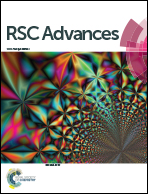A brand-new catalytic system: a Pd-based catalyst directly attached on the inner walls of the reactor which independently catalyzed the Heck reaction†
Abstract
A Pd-based catalyst directly attached on the inner surface of the reactor as a new catalytic system has been achieved and developed via an electrospinning technique followed by an impregnation–reduction and a simple carbonization process. The application of the reactor was demonstrated using the Heck reaction. This work showed many potential advantages in numerous fields.


 Please wait while we load your content...
Please wait while we load your content...